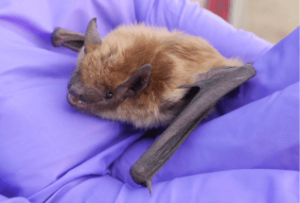White-nose syndrome causes loss of millions

At an evening about bats at Shelburne Farms I was surprised to find so many people. There were at least 25 gathered in the dark, warm library at the inn to watch a slide show given by Barry and Maureen Genzlinger, the husband and wife team who operate Vermont Bat Rescue Center in Milton. They gave us quite the show, with Barry doling out fascinating bat details while showing beautiful shots of a vast variety of bats from all over the world.
Among the facts we absorbed were the many types of bats there are in the world, including 700 different kinds of insect-eating bats, 250 kinds of “frugivores” that are dependent on fruit, 50 nectar-eating, seven carnivorous, five fish-eating (they swoop down on the rippled surface of a body of water where fish have risen to eat bugs and snatch their prey beneath the surface) and finally, three blood-eating bats. The old myth about blood-sucking bats and their supposedly vampirish tendencies is simply not true. The story of their parasitic behavior involves licking the skin of a chicken leg or cow’s wound until they can gently, surreptitiously lap blood from their victims who will never know of their blood loss. There will be no dual bite marks on necks.
But I was really there to hear about Vermont bats. All nine Vermont species are insectivores—and most of them are either threatened or endangered. Only one, the big brown bat, has healthy populations, and only one, the Indiana bat, is listed as federally endangered. Most of us who pay attention to the current state of bats have heard about white-nose syndrome and may also know that bats are vulnerable to this through their winter dwelling habitat, caves. According to Vermont Fish and Wildlife, “White-nose Syndrome (WNS) has resulted in the loss of more than 5.7 million bats in the northeastern United States since 2006. This disease has affected all six of Vermont’s cave bat species (bats that hibernate in caves and mines in the winter months). WNS is associated with a newly identified fungus that invades the skin and damages the tissue in hibernating bats.”
The fungus was first noted in a cave in Albany, N.Y., and spread quickly and widely through nearly all of the Northeast to as far south as Mississippi and east along the continental divide up into the eastern provinces of Canada. The spelunker who discovered WNS noticed a fuzz on bats’ noses and reported it. From there the fungus spread like wildfire to other states and caves. The bats itch from the fungus while in hibernation, waking often to scratch at themselves. The frequent waking and chafing at their small bodies exhausts them—and more important, they lose crucial body fat they need to hold them over through the winter months. Typically the level of fat on their tiny bodies lets them know when it’s time to awaken in the spring, but with the fungus they lose their orientation and come out of the caves long before their hibernation period would come to a close. Upon leaving the caves they freeze in the colder temperatures. The Dorset cave here in Vermont used to host around 250,000 bats in a winter, but that number dropped precipitously to 2,000 when WNS hit.
After the slide show and talk our group wandered out into the cooling evening and headed over to the large bat house near the shore of the inn. We listened some more to Barry, waiting for that perfect but mysterious moment when the bats would know to emerge. Suddenly one flew out, then another. We waited a bit more and then smallish groups slipped out and flew off into the night in search first for water and then, after their drink, to eat around 1,000 bugs per hour until dawn when they return to their cozy and very warm home. That’s a lot of mosquitos per night. If one considers that bats can live to be 12 to 15 years old, that’s even more mosquitoes than I want to calculate.
Here are some helpful tips about injured or orphaned bats. If you should encounter one that has managed to make its way into your home call 1-800-4rabies. This is particularly important if someone has been sleeping in a room where the bat has flown. Do not release that bat because you’ll want to be sure that Vermont Fish and Wildlife can test it for rabies. This is extremely important. For more information about bat rescue, check out the Vermont Bat Center website where you can get help with an orphaned or injured bat.

